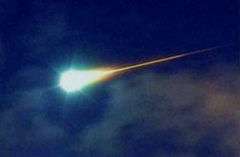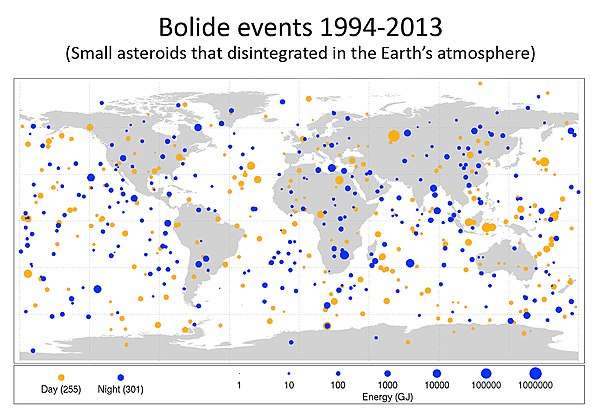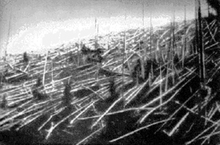Bolide
A bolide /ˈboʊlaɪd/ (Italian via Latin from the Greek βολίς bolís, "missile"[2][3]) is an extremely bright meteor, especially one that explodes in the atmosphere. In astronomy, it refers to a fireball about as bright as the full moon, and it is generally considered a synonym for a fireball. In geology, a bolide is a very large impactor.


One definition describes a bolide as a fireball reaching an apparent magnitude of −14 or brighter — more than twice as bright as the full moon.[4] Another definition describes a bolide as any generic large crater-forming impacting body whose composition (for example, whether it is a rocky or metallic asteroid, or an icy comet) is unknown.[5]
A superbolide is a bolide that reaches an apparent magnitude of −17 or brighter,[4][6] which is roughly 100 times brighter than the full moon. Recent examples of superbolides include the Sutter's Mill meteorite in California and the Chelyabinsk meteor in Russia.
Astronomy
_-_Meteorite.gif)
The IAU has no official definition of "bolide", and generally considers the term synonymous with fireball, a brighter-than-usual meteor; however, the term generally applies to fireballs reaching an apparent magnitude −14 or brighter.[4] Astronomers tend to use bolide to identify an exceptionally bright fireball, particularly one that explodes (sometimes called a detonating fireball).[7] It may also be used to mean a fireball that is audible.
Superbolide
Selected superbolide air-bursts events:
- Tunguska event (Russia, 1908)
- 2009 Sulawesi superbolide (Indonesia, 2009)
- Chelyabinsk meteor (Russia, 2013)
Geology
Geologists use the term bolide in a somewhat different context than astronomers do. In geology, it indicates a very large impactor. For example, the Woods Hole Coastal and Marine Science Center of the USGS uses bolide for any large crater-forming impacting body whose origin and composition is unknown, as, for example, whether it was a stony or metallic asteroid, or a less dense, icy comet made of volatiles, such as water, ammonia and methane.[5]
Gallery

See also
- Comet Shoemaker–Levy 9 § Impacts
- Earth-grazing fireball
- Meteor procession
- Tollmann's hypothetical bolide
References
- "We are not Alone: Government Sensors Shed New Light on Asteroid Hazards". Universe Today. Retrieved 12 April 2015.
- "Definition of BOLIDE". merriam-webster.com.
- "bolide". Oxford English Dictionary (3rd ed.). Oxford University Press. September 2005. (Subscription or UK public library membership required.)
- Belton, MJS (2004). Mitigation of hazardous comets and asteroids. Cambridge University Press. ISBN 0521827647.:156
- "Introduction: What is a Bolide?". Woodshole.er.usgs.gov. 1 April 1998. Retrieved 16 September 2011.
- Adushkin, Vitaly; Ivan Nemchinov (2008). Catastrophic events caused by cosmic objects. Springer. ISBN 1402064527.:133
- "bolide". Oxford Dictionary of Astronomy. Retrieved 1 September 2019.
External links
| Look up bolide in Wiktionary, the free dictionary. |
